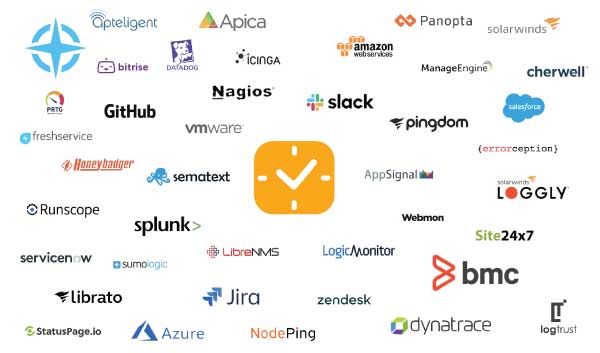An agent is a program installed on a physical server. An agent executes various server processes.
- Platform
Enterprise
Incident Management Simplified for Enterprises
Automate incident response, keep your stakeholders informed, and reduce downtime.
MSP
Everything an MSP needs.
24/7 live-call routing, on-call schedule management, advanced escalation policies, simple SLA management for all clients, and easy setup with seamless 1-one integration.
We’ve simplified your research process!
We created this special ConnectWise MSP bundle. It’s everything an MSP needs in 1 simple bundle.
- Solutions
Make AlertOps work for you. Keep your business humming
Don’t let your software limit what’s possible. Configure AlertOps to your vision and achieve groundbreaking results.
Use Cases
IT Operations
Get the flexibility to respond your way
Major Incident Management
Manage the unexpected with confidence
DevOps
Anticipate, automate and resolve in a flash
IT Service Management
Achieve service mastery
Managed Services Provider
Service beyond expectations
Industry
HealthCare
Respond faster when patient lives are on the line
Retail
Stay in control with real-time operational intelligence
Energy
Quickly mobilize during peak usage
Entertainment
Ready to drive positive customer experiences
Goverment
Streamline and optimize your process
Education
Protect your institution and enhance student and faculty experiences
- Integrations
Integrate with your favorite tools
Easily connect with monitoring, ITSM and ChatOps tools to identify, prioritize and resolve incidents. And use our no-code, Open API to seamlessly enrich your alerts and automate workflows.
- Pricing
Avoid complex billing and costly add-on modules.
Top Package
- Platform
Enterprise
Incident Management Simplified for Enterprises
Automate incident response, keep your stakeholders informed, and reduce downtime.
MSP
Everything an MSP needs.
24/7 live-call routing, on-call schedule management, advanced escalation policies, simple SLA management for all clients, and easy setup with seamless 1-one integration.
We’ve simplified your research process!
We created this special ConnectWise MSP bundle. It’s everything an MSP needs in 1 simple bundle.
- Solutions
Make AlertOps work for you. Keep your business humming
Don’t let your software limit what’s possible. Configure AlertOps to your vision and achieve groundbreaking results.
Use Cases
IT Operations
Get the flexibility to respond your way
Major Incident Management
Manage the unexpected with confidence
DevOps
Anticipate, automate and resolve in a flash
IT Service Management
Achieve service mastery
Managed Services Provider
Service beyond expectations
Industry
HealthCare
Respond faster when patient lives are on the line
Retail
Stay in control with real-time operational intelligence
Energy
Quickly mobilize during peak usage
Entertainment
Ready to drive positive customer experiences
Goverment
Streamline and optimize your process
Education
Protect your institution and enhance student and faculty experiences
- Integrations
Integrate with your favorite tools
Easily connect with monitoring, ITSM and ChatOps tools to identify, prioritize and resolve incidents. And use our no-code, Open API to seamlessly enrich your alerts and automate workflows.
- Pricing
Avoid complex billing and costly add-on modules.
Top Package
- Platform
Enterprise
Incident Management Simplified for Enterprises
Automate incident response, keep your stakeholders informed, and reduce downtime.
MSP
Everything an MSP needs.
24/7 live-call routing, on-call schedule management, advanced escalation policies, simple SLA management for all clients, and easy setup with seamless 1-one integration.
We’ve simplified your research process!
We created this special ConnectWise MSP bundle. It’s everything an MSP needs in 1 simple bundle.
- Solutions
Make AlertOps work for you. Keep your business humming
Don’t let your software limit what’s possible. Configure AlertOps to your vision and achieve groundbreaking results.
Use Cases
IT Operations
Get the flexibility to respond your way
Major Incident Management
Manage the unexpected with confidence
DevOps
Anticipate, automate and resolve in a flash
IT Service Management
Achieve service mastery
Managed Services Provider
Service beyond expectations
Industry
HealthCare
Respond faster when patient lives are on the line
Retail
Stay in control with real-time operational intelligence
Energy
Quickly mobilize during peak usage
Entertainment
Ready to drive positive customer experiences
Goverment
Streamline and optimize your process
Education
Protect your institution and enhance student and faculty experiences
- Integrations
Integrate with your favorite tools
Easily connect with monitoring, ITSM and ChatOps tools to identify, prioritize and resolve incidents. And use our no-code, Open API to seamlessly enrich your alerts and automate workflows.
- Pricing
Avoid complex billing and costly add-on modules.
Top Package

